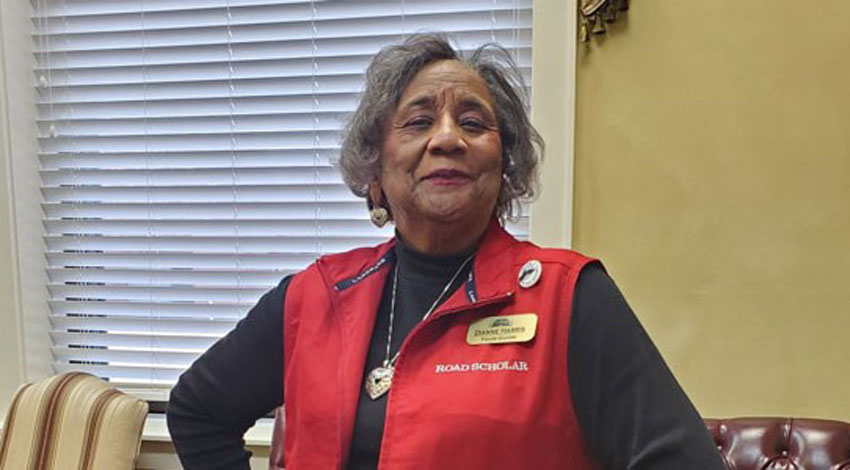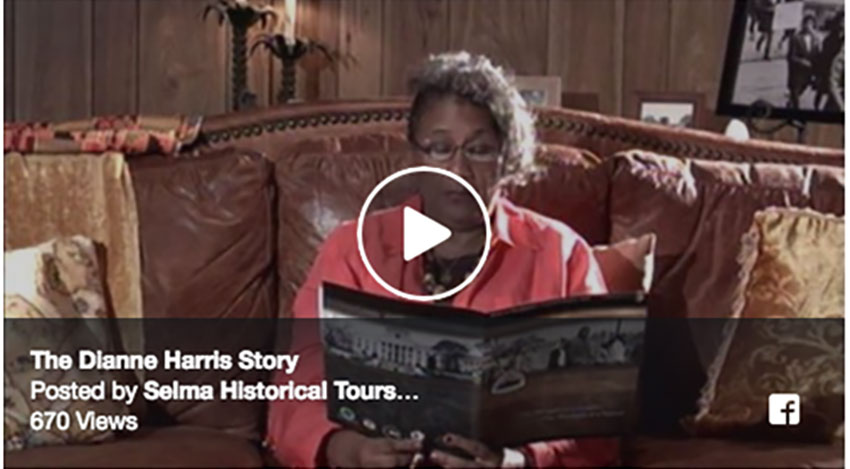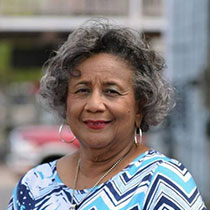Women with a Mission: T. Dianne Harris, Civil Rights Foot Soldier
A local of Selma, Alabama, Dianne Harris was 15 years old in 1965, when Jim Crow Laws were in full effect in Selma and throughout the South. “We had to go to the back of the bus. Blacks always had to be served at the back window at cafes. Water fountains in the public buildings would say ‘colored,’” says Dianne.
But during her time as a student activist, the Civil Rights Movement in Selma was focused on securing the right to vote for black Americans. The students played a very vital role in the movement because their parents were not allowed to vote. “If our parents had been seen trying to register to vote, many of them did lose their jobs,” says Dianne. “That’s why we chose to participate.”

A Jailbird Without a Record
Dianne and her 13-year-old brother took part in several marches and were arrested twice. One of those arrests took Dianne and her fellow student activists to a prison camp, where their finger prints and mug shots were taken. They spent several hours being verbally abused and spat upon. “All of this was to make us afraid, and we were.”
Many local farmers, community members and even the Harris family’s milk man, joined the possemen, volunteers deputized by the local sheriff to contain the marches. In their khaki uniforms, the possemen violently corralled the marchers on horseback. “Dr. King always stressed nonviolence,” says Dianne. “But I saw violence practiced on us.”
The second time Dianne was arrested, she and the other students spent the entire night at the National Guard armory, where possemen used cattle prods and Billy clubs on her and her friends. “It did leave some emotional scars,” says Dianne. “But I’m honored to be a jailbird without a record.” The students’ records were expunged.
Dianne and her brother also participated in the march that would become known as Bloody Sunday. “When we heard the marchers screaming and crying and could smell the tear gas, we ran back. The church was our safe haven.” This church, Brown Chapel AME Church, is where Road Scholar participants assemble to hear Dianne’s story.
Despite the threat of violence, Dianne says she never considered giving up. “I was always afraid, but I never felt like quitting,” she says. “We were encouraged not to participate by our school for fear of the violence, but I wanted to be part of the history. It was truly an awesome experience, and I don’t regret having participated.”
In March of 1965, Dianne and her brother boarded a Greyhound bus bound for Montgomery to join the Selma-to-Montgomery March lead by Dr. Martin Luther King, Jr. “We marched from St. Jude Catholic School, and that’s when we heard Dr. King’s famous speech on the steps of the state capitol.”
The perseverance and sacrifices of the foot soldiers of the Civil Rights Movement in Selma and beyond led to the passing of the Voting Rights Act in August of 1965.

The Struggle Continues
After high school, Dianne went on to major in elementary education with a minor in special education. She taught special education in the Selma school system for 27 years, and now, at the age of 68, educates visitors to Selma on the Civil Rights history and the work that still needs to be done today in the fight for racial equality.
“The struggle continues,” says Dianne. “The racial climate today is better than it was back in the ‘60s, but we’re not where we should be. There is always going to be room for improvement. We still need to continue to unify.”
Dianne continues her legacy of supporting every citizen’s right to vote. During elections, she volunteers answering phones and driving people to the polls. “I haven’t let the true meaning of what we fought for die within me. I always make sure I vote, and I encourage anyone I meet to vote, too.”
Women Inspiring Women
Over 2,000 students at the local high schools participated in the student movement in 1965. Like many other residents of Selma, Dianne’s mother allowed her children to participate in the marches because she couldn’t participate herself during the day. As a single mother and the breadwinner of the family, she couldn’t risk being seen organizing for fear of losing her job. “She was working, but she as doing her civil rights duty incognito,” says Dianne.
Dianne’s mother attended “Mass Meetings” at night and took part in the cause whenever she could. “When Dr. King sent out a call to house volunteers coming to Selma, I was so proud of my mom. She went down and signed her name to house two people.” A young white couple from New York stayed with Dianne’s family for a week, and they stayed in touch for many years after.
Dianne says that, when she was an adult, she asked her mother if she had ever been afraid for her children. “She said, ‘of course!’ All you could do was pray and hope that your children were safe.” But Dianne’s mother still allowed her children to participate. “I don’t know where that bravery came from, but I have to say I have a lot of it in me.”
Not only did Dianne have an impact on the Civil Rights Movement, but the Civil Rights Movement and its leaders also had a great impact on her. Of the eight key leaders of the Civil Rights Movement in Selma, two of them were women: Marie Foster and Amelia Boynton Robinson. In iconic images from Bloody Sunday, Amelia can be seen being dragged because of her injuries. Dianne says that these two women also served as great inspiration for her. “I always felt that they were very brave women to be able to stand up there with the men.”
She says that her involvement in the movement taught her to stand up for herself and made her a strong, self-confident individual. “It’s taught me to be a strong person and be proud of my African American heritage. It taught me how to speak up when I saw injustices. If I see something going on that’s wrong, I see something and do something.”
Dianne hopes to instill that confidence and power in the young women she interacts with at her sorority. She encourages other women to continue that legacy by being a role model for someone else. “Reach back and pull someone else up. If each one touches one, we’ll make a better world.”
About Dianne:
Dianne Harris shares her experiences as a freedom fighter with Road Scholars on our“Heart of the Civil Rights Movement” program as she joins participants for a visit to Brown Chapel AME Church and a walk across the Edmund Pettus Bridge.

